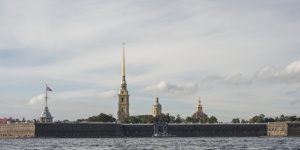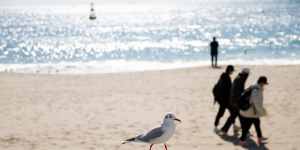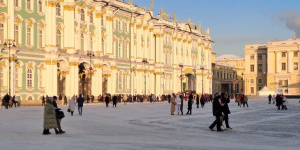Cultural and educational tourism in St. Petersburg
(Photo: pixabay.com)
Historical St. Petersburg: museums, monuments, city center, archive
(State Museum of the History of St. Petersburg (Peter and Paul Fortress) Peter and Paul Fortress, 3)
The Museum of the History of the City on the Neva River holds more than 1.5 million exhibits in its funds. With their help, a retrospective of the history of St. Petersburg from the foundation to the present day is reconstructed easily and interestingly. The museum complex includes several branches, but the Peter and Paul Fortress is considered its center. The territory includes the Peter and Paul Cathedral with the Grand Ducal Burial Vault, as well as the Museum of Cosmonautics and much more.
(Russian Museum of Ethnography Inzhenernaya st., 4/1: weekdays, weekends 350; preschoolers and schoolers are free; pensioners, students 100)
In the very center of St. Petersburg there is a unique museum of ethnography where visitors are introduced to the culture and traditions of the peoples of Russia and neighboring countries. The museum was called the "ethnographic Hermitage" for a reason, its collection holds more than 500,000 objects, dating back to the 18th century. In the museum halls are galleries of unique ethnic costumes, (from fish skin or nettles, for example), expositions of ceremonial weapons of the Caucasian peoples or the totems of Far Eastern shamans, and much more.
(Photo: ethnomuseum.ru)
(Military Historical Museum of Artillery, Engineers and Signal Corps Aleksandrovsky park, 7: weekdays, weekends 300; preschoolers are free; pensioners, students, schoolchildren 150)
One of the largest military museums in the world is located in St. Petersburg. Its area is 17,000 square meters, and the exhibition has more than 850,000 exhibits. In 1703, Peter the Great ordered the construction of the Armory for the storage of ancient artillery pieces gathered throughout the empire. To date, the museum (both in the open air and inside) presents large-scale collections of artillery pieces and ammunition, military-engineering equipment, all kinds of military uniforms, works of battle art, as well as award medals and historically valuable archival documents.
(Peter the Great Museum of Anthropology and Ethnography (Kunstkamera) Universitetskaya emb., 3: weekdays, weekends 400; preschoolers are free; pensioners, students 100)
One of the oldest museums in St. Petersburg was created by the founder of the city, Peter the Great. The unique feature of the Kunstkamera is that its collection contains relics and artefacts of different nations. Even today, the museum remains one of the largest scientific centers for the study of the cultural heritage of man. Tourists are also attracted by a special exhibition hall, where a collection of anatomical anomalies is shown (the lamb with two heads preserved in alcohol, for example). But first of all, the museum will be interesting from the point of view of discoveries in the fields of archeology, anatomy and medicine.
(Photo: instagram.com/kunstkameramuseum)
(Petrovskaya Akvatoria Malaya Morskaya st., 4/1: weekdays, weekends 480; preschoolers 280; retirees, students 380)
A large-scale model of the XVIIIth century St. Petersburg with a real body of water will show visitors how the Northern Capital and the Russian fleet were born. Of particular interest are dynamically moving objects, sound and light effects, including a change of day and night and a very realistic change in weather conditions. Since the model is called the "akvatoria" (water area), the central piece is the space filled with water, where the ships from the time of Peter I cruise, recreated according to the original drawings.
(Grand Maket Russia Tsvetochnaya st., 16: weekdays, weekends 540; to preschool children, pensioners 320)
Grand Maket is a great opportunity to see the whole modern Russia without leaving St. Petersburg. On a space of 800 square meters on a scale of 1 to 87, the composite characters of the Russian regions are presented. In addition to miniature buildings and tiny country residents, trains, ferries, cars, and traffic lights flash are here. Every fifteen minutes from east to west the night falls on the Maket. There are representative views of the south of Russia with huge fields of sunflowers, far-reaching snowy Siberia and never dying out lights of the megapolises of Moscow and St. Petersburg.
(Photo: pixabay.com)
Art in St. Petersburg. Museums
(Winter Palace of Peter I Dvortsovaya emb., 32: weekdays, weekends 400; preschoolers, senior citizens, students for free, foreigners 800)
The State Hermitage Museum, founded in 1764 from the collection of Empress Catherine II, has been attracting millions of tourists every year for more than 250 years and is included in the world top 20 most visited art museums. The Hermitage collection occupies five buildings and includes a huge number of works of art and monuments of world culture, from the ancient world to the present. The most significant exhibition complex of the museum is the Winter Palace, which used to be the imperial residence, and is now considered a unique example of the Baroque architectural style.
(The Mikhailovsky Palace. The State Russian Museum Inzhenernaya st., 4: weekdays, weekends 450; preschoolers are free; pensioners, students 200, foreigners 600)
The first museum of fine art in Russia was established in 1895 by the last emperor of Russia Nicholas II. Today, the museum collection has more than 400,000 exhibits, and there is almost no famous Russian artist whose work would not be presented here. The main part of the exposition is located in two places: the Mikhailovsky Palace and the Benoit Wing. The most famous exhibits of the museum: "The Ninth Wave" by I.K. Aivazovsky, "The Last Day of Pompeii" by K.P. Bryullov, "The Zaporozhian Cossacks" by I.E. Repin and others.
(Photo: instagram.com/russian_museum)
(Erarta 29th line of Vasilievsky Ostrov, 2, weekdays, weekends 800; pensioners, students 600)
The Erarta Private Museum of Contemporary Art has more than 2,300 art objects, including paintings, installations, and video art. In 2015, Erarta became available on Google ArtProject, so millions of users from all over the world can get acquainted with the museum collection. Despite the fact that the majority of Erarta collection consists of the works of St. Petersburg artists, the museum also collaborates with both regional and foreign talents.
(Pushkinskaya-10 Ligovsky pr., 53: weekdays, weekends 250; pensioners, students 100)
Another center of contemporary art in St. Petersburg is the Pushkinskaya-10 Art Center. From 1989 to the present days, Pushkinskaya-10 is the only non-governmental and independent creative community in Russia, consisting of independent artists, musicians and other artists. In the courtyard of the art center is the famous John Lennon Street where a yellow submarine is drawn on a brick wall. Among the most famous residents of the center are such artists as Yuri Shevchuk, Boris Grebenshchikov, Kolibri band and others.
(Photo: vk.com/pushkinskaya10)
Literary places of St. Petersburg
(Museum-apartment of A.S. Pushkin Moyka emb., 12: weekdays, weekends 380; preschoolers are free; pensioners, students 210)
Museum-apartment of Alexander Sergeyevich Pushkin on the Moyka River gives visitors opportunity to see the personal belongings of the famous Russian poet and his family, and also talks about how the "the Sun of Russian poetry" spent the last months of his life. It was this apartment near the Konyushenny Bridge where the mortally wounded Pushkin was brought from a duel on January 29, 1837. The apartment consisting of 11 rooms was reconstructed according to the memoirs of poet's contemporaries and archival documents.
(F.M. Dostoevsky Literary and Memorial Museum Kuznechny Lane, 5/2: weekdays, days off 250; retirees, students 100)
The house on Kuznechny Lane was completely redesigned into communal apartments during Soviet times, so it was needed to recreate Dostoevsky's office, living room and other rooms of the apartment bit by bit, studying archival data and photographs. Fyodor Mikhailovich wrote his last novel, The Brothers Karamazov here. The museum unique feature is a theater where performances are staged every night, including those based on the works of the writer.
(Photo: vk.com/dostoevskymuseum)
(A. Blok Apartment Museum Dekabristov st., 57: weekdays, weekends 200; preschoolers are free; pensioners, students 150)
The museum on Dekabristov Street is located in the same house where Alexander Blok lived from 1912 to 1921. This is the first Silver Age culture museum in St. Petersburg. It consists of two parts: a memorial apartment, where the atmosphere of the period when the poet himself lived here was recreated, and a literary exhibit located on the floor above. Visitors will be able to see Blok's manuscripts preserved to this day, personal books of the poet and things belonged to the Blok family.
(Anna Akhmatova Literary and Memorial Museum at the Fountain House Liteyny pr., 53: weekdays, weekends 200; preschoolers, students for free; seniors, schoolers 100)
Another museum dedicated to the Silver Age poet is located on Liteyny Prospekt. In the Fountain House, which is the garden wing of the Sheremetev Palace and where Nikolai Punin's apartment was previously situated, the Russian poetess Anna Akhmatova lived for almost 30 years. In addition to the memorial apartment of Akhmatova, the exposition "Brodsky's American Cabinet", various exhibitions, recitals and concerts are held here.
(Photo: vk.com/akhmatova.museum)
(The Nabokov Museum Bolshaya Morskaya st., 47, weekdays, weekends 200)
The world's only museum of V.V. Nabokov is located in the very center of St. Petersburg where the writer was born. He is the author of such novels as "Lolita", "The Luzhin Defense", "The Gift" and others. The museum's collection consists of personal items of Nabokov and his family. The room itself, which sadly has not preserved its original interior serves as an exhibition hall. Since 2008, the museum has become part of the Faculty of Philology of St. Petersburg State University.
(Photo: mikhailovsky.ru)
Theater St. Petersburg: museums, ticket offices, poster
(Alexandrinsky Theater Ostrovsky sq., 6)
Founded by the daughter of Peter the Great, Elizabeth the theater today bears the name of Empress Alexandra Feodorovna (it is also known as the State Russian Drama Theater named after Pushkin). The building, located in the heart of Nevsky Prospekt, hosted high-profile premieres of such famous plays as "Woe from Wit" by A.S. Griboyedov, "The Government Inspector" by N.V. Gogol, "The Seagull" by A.P. Chekhov and "The Storm" by A.N. Ostrovsky. The Alexandrinsky Theater is currently led by Valery Fokin. The front lobby, the majestic facade and the large auditorium with five tiers allowed the theater to be included in the UNESCO list of architecture.
(Mariinsky Theater Teatralnaya sq., 1)
The Mariinsky Theater, named after Empress Maria Alexandrovna and having a 230-year history behind it, still amazes the audience with its huge size and magnificent decoration of the hall. On its legendary stage, the premieres of famous operas like "Boris Godunov" by Mussorgsky, "The Snow Maiden" by Rimsky-Korsakov, "Prince Igor" by Borodin and others were staged. It was at the Mariinsky Theater where the legendary French choreographer Marius Petipa directed the Imperial Ballet for 50 years. The masterpieces of classical Russian ballet, known all over the world: "The Sleeping Beauty", "Swan Lake", "The Nutcracker" were also created here. Since 1988, Valery Gergiev took the position of art director of the famous musical theater.
(Mikhailovsky Theater Arts sq., 1)
Another symbol of St. Petersburg is the Mikhailovsky Theater. It opened its doors in 1833 and still fascinates with the brilliance and luxury of the imperial decoration inside. Classic traditions go hand in hand with innovation and experimental ideas in this theater. The legendary Feodor Chaliapin sang, Johann Strauss conducted, and Soviet operas were staged here. However, the theater holds the image of a classical theater with Russian classical performances, which are equally well-received by foreign tourists and the Russian audience.
(Photo: Stas Levshin, www.philharmonia.spb.ru)
Musical St. Petersburg
(The Grand Hall of the St. Petersburg Philharmonia Mikhailovskaya st., 2: weekdays, weekends 400)
St. Petersburg is also known for its musical history, which can be found in the St. Petersburg Academic Philharmonia named after D.D. Shostakovich. Divided into two halls, the philharmonic collects the best works of classical music on its stages, and the repertoire is chosen so that it includes composers from different eras. The grand philharmonic hall is intended for large concerts and musical evenings, while the small hall stages chamber concerts, but also receives world-class stars.
(St. Petersburg State Academic Chapel Moyka emb.,20: weekdays, weekends 700)
The history of the chapel dates back to the 15th century, when Ivan the Terrible created a choir of choirmen, which will be renamed into the Imperial Court Chapel after 300 years. The repertoire is generally represented by the world of symphonic music: Bach, Mozart, Tchaikovsky, Mussorgsky and others can be heard here. Thanks to its unique acoustics, the academic chapel is among the best in Europe.
In addition to museums and theaters, St. Petersburg attracts tourists with the large-scale holidays and festivities, when the city shows its other face. Among the holidays that attract millions of spectators, the most famous are the following: Maslenitsa - a Russian-national holiday, which celebrates the arrival of spring on a grand scale; Scarlet Sails - a large-scale festival of school graduates, which ends with fireworks and the beautiful sailing-ship with scarlet sails entering the Neva water area; City Day, Navy Day.






